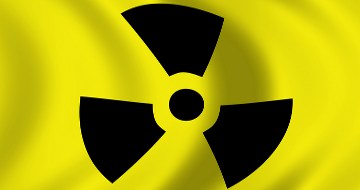
Astatine
Astatine General
| Name:Astatine | Symbol:At |
| Type:Halogen | Atomic weight:210 |
| Density @ 293 K:7 g/cm3 approx | Atomic volume:cm3/mol |
|
Discovered:
Astatine was first produced in 1940 by Dale Corson, Kenneth MacKenzie, and Emilio Segrè at the University of California by bombarding bismuth with alpha particles. They named the new element "astatine", from the Greek "astatos", meaning "unstable". Traces of the element were discovered later naturally in uranium and thorium isotopes. |
|
Astatine States
| State (s, l, g):solid | |
| Melting point:575.2 K (302 °C) | Boiling point:610 K (337 °C) |
Astatine Energies
| Specific heat capacity: J g-1 K-1 | Heat of atomization:92 kJ mol-1 |
| Heat of fusion:6 kJ mol-1 approx | Heat of vaporization :40 kJ mol-1 |
| 1st ionization energy:890 kJ mol-1 | 2nd ionization energy: kJ mol-1 |
| 3rd ionization energy: kJ mol-1 | Electron affinity:270 kJ mol-1 |
Astatine Oxidation & Electrons
| Shells:2,8,18,32,18,7 | Electron configuration:[Xe] 4f14 5d10 6s2 6p5 |
| Minimum oxidation number: -1 | Maximum oxidation number:7 |
| Min. common oxidation no.: -1 | Max. common oxidation no.:1 |
| Electronegativity (Pauling Scale):2.2 | Polarizability volume:6 Å3 |
Astatine Appearance & Characteristics
| Structure:Unknown | Color:Presumed very dark |
| Hardness:mohs | |
|
Harmful effects:
Highly radioactive |
|
|
Characteristics:
Astatine is the rarest element on earth. It is only available in tiny quantities. Its properties are inferred from its position in the periodic table and by studying its chemistry in extremely dilute solutions. Astatine is highly radioactive and like the other halogens would be expected to form salts with metals such as sodium. Astatine can also react with hydrogen to form hydrogen astatide, which when dissolved in water, forms hydroastatic acid. Astatine is the least reactive of the halogens and exhibits the most metallic properties of the halogen group. Uses: 211Astatine is sometimes used as a radioactive tracer and in cancer treatment. Like iodine, it is known to accumulate in the thyroid gland. |
|
Astatine Reactions
| Reaction with air: | Reaction with 6 M HCl: |
| Reaction with 15 M HNO3: | Reaction with 6 M NaOH: |
Astatine Compounds
| Oxide(s): | Chloride(s): |
| Hydride(s):HAt |
Astatine Radius
| Atomic radius:pm | Ionic radius (1+ ion):pm |
| Ionic radius (2+ ion):pm | Ionic radius (3+ ion):pm |
| Ionic radius (2- ion):pm | Ionic radius (1- ion):pm |
Astatine Conductivity
| Thermal conductivity:1.7 W m-1 K-1 | Electrical conductivity: S cm-1 |
Astatine Abundance & Isotopes
| Abundance earth's crust:25 grams exists in Earth's crust at any given time. | |
| Abundance solar system:negligible | |
| Cost, pure:$ per 100g | |
| Cost, bulk:$ per 100g | |
|
Source:
Astatine is produced synthetically by bombarding bismuth with alpha particles. It can be obtained naturally from thorium or uranium decay. |
|
|
Isotopes:
More than 30 isotopes of astatine have been identified. All are very short-lived; 210At has the longest half-life of 8 hours 10 minutes. |
|
Astatine Other
|
Other:
|
|
Prev: Polonium Next: Radon |